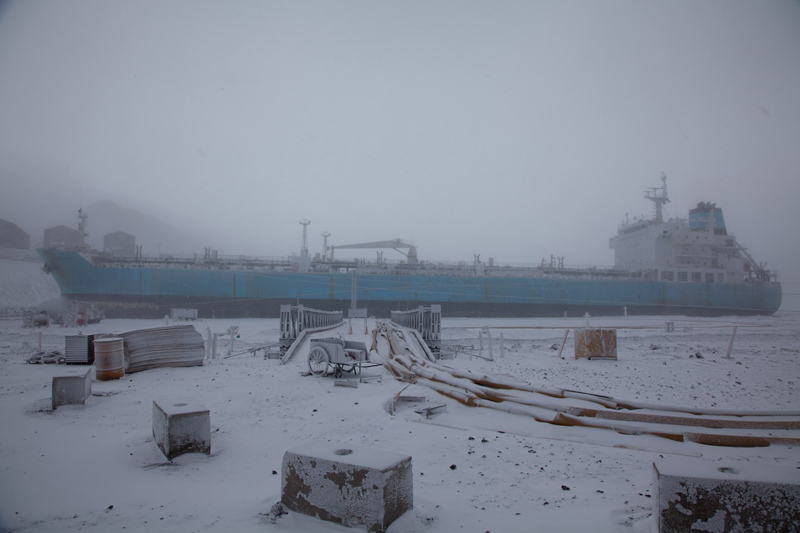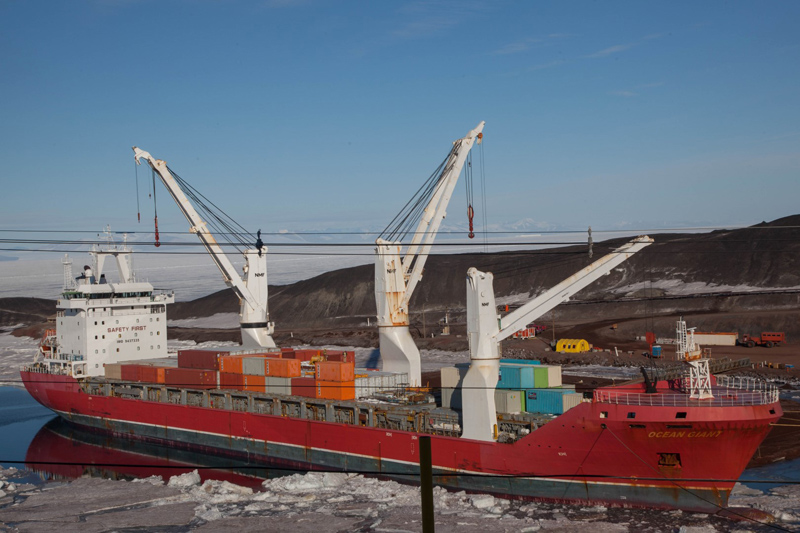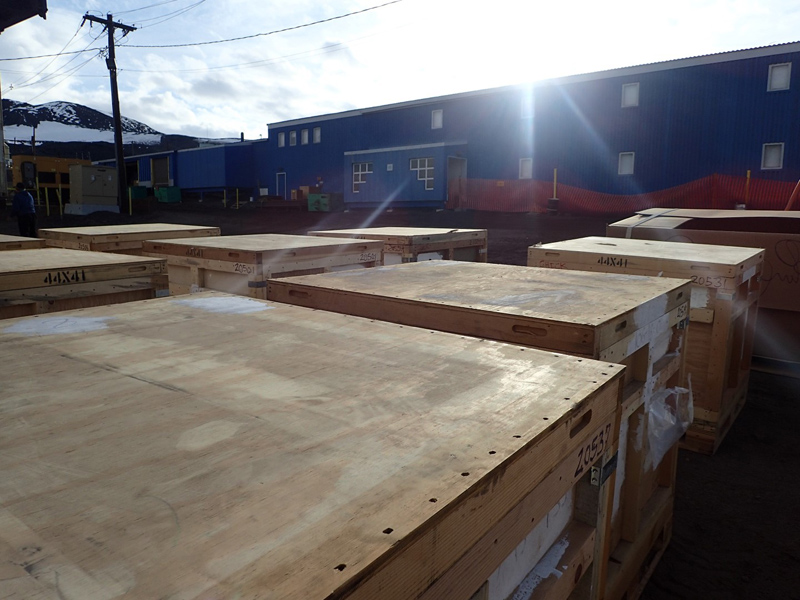
Photo Credit: Laura Gerwin
|
The tanker ship USNS Maersk Peary docked at McMurdo Station’s ice pier is covered by a late season snowfall.
|
As Residents Depart, Winter Arrives
By Michael Lucibella, Antarctic Sun Editor
Posted March 2, 2016
Winter has arrived in Antarctica.

Photo Credit: Laura Gerwin
The cargo vessel, USNS Ocean Giant unloads supplies at McMurdo Station’s ice pier.
Operations at McMurdo Station and the Amundsen-Scott South Pole Station have transitioned into winter mode as the residents prepare for nearly four months of total darkness. The last flight of the season left the South Pole on February 16 and the last regular flight out of McMurdo left on March 2.
At McMurdo, perhaps the first, concrete sign that the austral summer season was drawing to a close came with the annual arrival of the cargo and tanker ships. For two weeks in late January and early February personnel at the station worked around the clock to unload supplies and fuel, and to load the cargo ship with outgoing science samples, waste and recyclable materials. Once the vessel operations were complete, efforts switched to preparing the station for winter and swapping out the summer crew for those staying through the winter.
“At the moment we’re seeing the typical bustle that comes with the transition from one team to another,” said Pedro Salom, the support contractor’s winter site manager at McMurdo, a few days before the changeover finished.
The station’s population has dwindled significantly as the majority of residents have left for the season. At its peak, more than 900 people worked at McMurdo, but now only a fraction remain after most of the summer workers have gone. After all the flights wrapped up, only about 150 workers remain at the station for winter.

Photo Credit: Laura Gerwin
After being offloaded from the ship, boxes of supplies are staged in front of Building 155 before distributed to their storage centers around the station.
“We have a steady stream of northbound redeploying folks, so town is getting quieter every day,” Salom said.
The field camps have all been closed down and support operations for them are likewise shuttered for the season.
“There are no more helicopters flying through the air, the machines with backing alarms have been parked for the winter and the galley is still,” said Laura Gerwin, a shuttle driver just before she redeployed. “Things are quiet.”
Though most research projects have wrapped up for the season, a major experiment has been installed and is taking data through the winter. The Department of Energy’s Atmospheric Radiation Measurement (ARM) West Antarctic Radiation Experiment (AWARE) is measuring climate data coming in from across West Antarctica. A small white structure is perched on the hill between McMurdo Station and New Zealand’s Scott Base, housing dozens of instruments collecting data on the region’s temperature, humidity, cloud cover and weather.
Work will continue over the winter on Alpha Runway, the new airfield under construction on the ice shelf. Other construction projects at McMurdo Station include refurbishing one of the dormitories, and upgrading the laundry facility and some of the Crary laboratory’s air-handling control systems.
However, this year won’t be as isolated as it has been in the past. Five flights, each spaced about a month apart, will deliver fresh supplies, mail and personnel throughout the winter. These winter flights began last year as a pilot program and are now a permanent fixture of McMurdo’s austral winter schedule.

Photo Credit: Michael Lucibella
The Amundsen-Scott South Pole Station will not see flights in or out for nine months. (File photo)
At Amundsen-Scott South Pole station, 850 miles south, the 48-member wintering crew is settling in for nine months of isolation. The last flight left in mid-February, and the next one won’t arrive until early November. The station is down to less than a third of its peak summer population.
“The first few weeks of winter are spent winterizing buildings and equipment, while at the same time running the station, and starting preparation of projects to get started for winter,” said Craig Knott, the winter site manager at Pole.
High on the agenda for this season is cleaning and re-leveling the station’s fuel tanks, upgrading the fire suppression systems in the main elevated station as well as in the emergency power plant and some general maintenance.
“A lot of prep goes into station close,” said James Tarragano, a meteorologist at the station. “We are currently getting light blockers ready [for the windows] due to the light sensitive experiments.”
Unlike at McMurdo, the majority of the science that takes place at South Pole happens in winter. The light blockers are to prevent the lights from the station from interfering with the all-sky cameras observing the aurora, and three large telescopes that are likewise gearing up to scan the heavens after a summer of maintenance.
Over the frigid winter, most of the heavy equipment gets stored away so the extreme temperatures as low as -100 degrees Fahrenheit don’t damage the machines. It adds an extra challenge for the maintenance specialists.
“Daily rounds are still done all winter, but with fewer personnel and no vehicles to get around,” Knott said. “Whenever they have to go to a distant building to check something, they have to walk because it is too cold to drive most of the equipment in the winter.”
He added that he was excited for the season to start so the winter crew could start working their projects.
For many, the last flight of the season brought on a range of emotions about the remoteness and inaccessibility of winter. It can be challenging to work where there are no flights for months, thousands of miles from the nearest city with limited communication back home.
“The very first thing that went through my mind was a bit of worry. I have had planes here all summer and if I needed to get home I could. Now it’s just us that are here,” Tarragano said. “My second thought was, ‘Okay, I got this.’”








